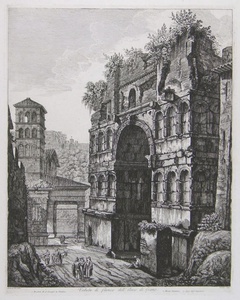| Method | Etching with engraving |
| Artist | Luigi Rossini |
| Published | Rossini dis. e inc. Roma 1820 |
| Dimensions | Image 440 x 355 mm, Plate 455 x 365 mm, Sheet 745 x 533 mm |
| Notes |
Inscription reads: '1. Basilica di S. Giorgio in Velabro. 2. Monte Palatino. 3. Arco degli Argentieri' Plate 55 from Le Antichita Romane, ossia Raccolta della piu interessanti Vedute di Roma Antica, depicting one side of the four-faced Arch of Janus. Numbered and described in the background are the Basilica of Saint George in the Velabrum, part of the Farnese palace on the Palatine Hill, and the Arcus Argentariorum ('Arch of the Money-changers'). Aside from providing a view of the Arch of Janus before the removal of the upper level of the monument in the 1830s, Rossini's view is also one of very few images that provide details of the Arch of the Money-Changers. The monument, erected by private citizens in honour of the emperor Septimius Severus and his sons, was badly damaged by a car-bomb in 1993. The Arch of Janus was actually a quadrifons (four-faced) triumphal arch, probably built during the 4th century AD in honour of Constantine the Great, or his son Constantius II. The arch was built with recycled material from earlier monuments and spanned a crossroads at the Velabrum. The attribution to Janus, the Roman god of beginnings, endings, and transition, was due to the fact that the Arch faced in four different directions at once. Like many other monuments of Roman antiquity, the Arch was fortified in the Medieval period by the powerful Frangipane family. Le Antichita Romane, ossia Raccolta della piu interessanti Vedute di Roma Antica was Rossini's largest series of engravings, and the most popular with his clients. The 101 plates of views of the remains of Ancient Rome were completed between 1819 and 1823. The influence of Piranesi and the other great etchers of the 18th century is immediately apparent when looking at Rossini's work. In some cases, Rossini's perspectives match almost exactly those executed by Piranesi in the previous century, with an equal attention to architectural detail. As a result, the viewer is provided with a fascinating record of the changes wrought on Rome's most famous monuments in the time between the two artists. Luigi Rossini (1790-1857) was an Italian painter and etcher. Born in Ravenna, he studied art and architecture at the Academy of Bologna with Antonio Giuseppe Basoli and Giovanni Antonio Antolini. He graduated in 1813. Similarly to Giovanni Battista Piranesi, Rossini is best known for etchings of classical Roman architecture including the Pantheon, the Colosseum, the Appian Way, the Temple of Peace, and the Golden House of Nero. Rossini was also influenced by more rural settings, and produced etchings of the landscape surrounding Rome. His first series of views were published in 1814. He began his Roman antiquities series in 1819, completing 101 large folio plates which were published in Rome in 1825. Condition: Excellent clean impression. Light staining to top margin of sheet, not affecting plate or image. |
| Framing | unmounted |
| Price | £550.00 |
| Stock ID | 31347 |

